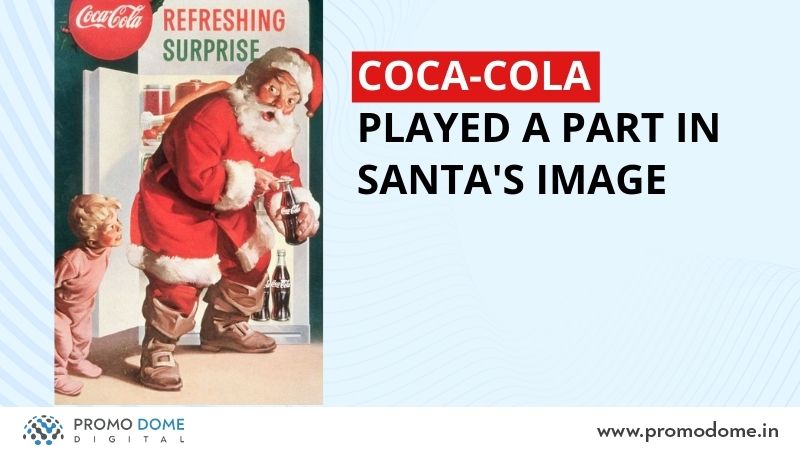Christmas facts are always an exciting topic of discussion at Christmas parties and get-togethers. But that stuff is for muggles; we marketers are a wildly different species.
Whether it’s Christmas or Diwali, as people sift through presents and sweets, we are busy looking for insights to help hone our next marketing campaign. But, yeah, we ain’t normal!
So for Christmas this year, as the majority of the population was looking for gift and decoration ideas, we scavenged through hundreds of Christmas facts to catch the ones born from clever marketing gimmicks. (Spoiler alert: Your mind is about to be blown)
Here’s a digital marketing plan that guarantees an increase in sales.
Table of Contents
Christmas Facts About Traditions That Came From Marketing
Christmas Fact1: Coca-Cola created the Santa Claus we know today
Oh HO HO HO, So the warm and fuzzy Santa that we grew up loving wasn’t always the image of Santa Claus? (triggering trust issues)
Coca-cola didn’t invent Santa Claus, but it has massively influenced how we imagined him for the last 100 years. Before 1932, Santa Claus used to be everything from a tall gaunt man to a spooky-looking elf. Hard to imagine, isn’t it?
That’s how successful Coca-cola’s marketing strategy turned out to be. It obliterated every image of Santa Claus there had ever been.

Coca-cola commissioned an illustrator named Haddon Sundblom to create a realistic and wholesome image of Santa Claus that people can easily fall in love with. (Talk about achieving marketing goals)
Drawing inspiration from Clement Clark Moore’s famous poem “A visit from St. Nicholas” (also known as Twas the Night before Christmas), Sundblom brought to life a chubby little old man with a flowing silver beard and rosy cheeks that captured our hearts and Christmas spirits forever.
People so madly fell in love with this new image of Santa that every movie, advertisement, story, and cartoon has since depicted Coca-Cola’s version of the gift-bearing old man, turning a marketing tactic into a Christmas legend.
Oh, did you think it’s a coincidence that Santa Claus wore red?
Christmas fact 2: A retail-store employee drew Rudolph to bring in customers
Just like Santa Claus, the red-nosed reindeer is the offspring of an incredibly successful marketing ploy.
Rudolph first appeared in a marketing campaign for retailer Montgomery Ward. Every Christmas, the company gave away coloring books to get children and their parents into their store. Then, in 1939, the company decided to produce the books themselves to cut costs. And that’s where Robert May, a store employee, came up with a poem featuring Rudolph.

A relatable small, shy character who is ostracized by those around him won hearts and massive sales for the company. As its popularity grew, Rudolph started appearing in cartoons, songs, comics, animations, and even a feature-length film, making the company richer.
Now that’s a fairy tale success story.
While Rudolph was undoubtedly successful as an initial advertising campaign, he does not enjoy the same association with Montgomery Ward that Santa Claus does with Coca-cola.
That’s because, in a rare act of corporate generosity, the Montgomery ward handed over the Rudolph rights to its creator in 1947, who was struggling financially after the passing of his wife.
May went from being broke to becoming a millionaire through licensing the character while sneaking Rudolph into common Christmas folklore.
Now that’s a perfect Christmas story!
Christmas fact 3: KFC hit home in Japan with its “Kentucky for Christmas” campaign
KFC to Japan on Christmas is like Turkey to America on Thanksgiving.
Digging in the bucket to grab the famous KFC chicken wings with your family on a chilly Christmas night has become a tradition in Japan. The idea of having KFC on Christmas might sound incredulous to Americans, but it’s an integral part of Christmas in Japan.

It all started with KFCs incredible advertising campaign, “Kentucky for Christmas,” the brilliant marketing campaign worked because it filled a void. Before the campaign, there was no tradition for Christmas in Japan, and so when KFC came in and said, this is what you should do on Christmas, people hopped onto it.
The campaign gave people an excuse to spend quality time with their family and share a meal; isn’t that what Christmas is all about?
The trend has bloomed so wildly that you need to get a reservation 2 months in advance to have a chicken wings bucket on Christmas.
Conclusion
Christmas facts and marketing campaigns never cease to amaze.
